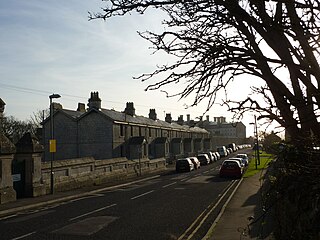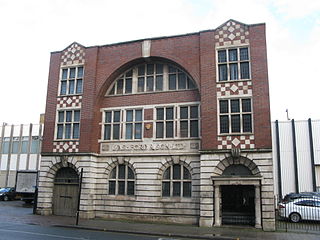
A listed building, or listed structure, is one that has been placed on one of the four statutory lists maintained by Historic England in England, Historic Environment Scotland in Scotland, Cadw in Wales, and the Northern Ireland Environment Agency in Northern Ireland.

Easton is a village on the Isle of Portland in Dorset, England. The village is situated at Tophill, within the centre of the island. As with the rest of Portland's villages and settlements, Easton, including the settlements Reforne and Straits, has been designated as a conservation area, as it is a place of special architectural and historic interest. Easton, Wakeham and Reforne were designated pre-1974.

Henry Richard Yeoville Yardley Thomason was a British architect active in Birmingham. He was born in Edinburgh to a Birmingham family, and set up his own practice in Birmingham 1853–54.

Julius Alfred Chatwin FRIBA, ARBS, FSAScot was a British architect. He was involved with the building and modification of many churches in Birmingham, and practised both Neo-Gothic and Neo-Classical styles. His designs always included all of the carvings and internal fittings.

Philip Boughton Chatwin was an architect in Birmingham, England.

Holland William Hobbiss, was an English architect in the Birmingham area. He traded under the names Holland W. Hobbiss and Partners and Holland W. Hobbiss and M. A. H. Hobbiss.

Arthur John Bridgeman ARCA, FRBS, FRBSA was an English sculptor.

Charles Edward Bateman FRIBA was an English architect, known for his Arts and Crafts and Queen Anne-style houses and commercial buildings in the Birmingham area and for his sensitive vernacular restoration and extension work in the Cotswolds.

The Church of the Ascension is a Church of England parish church in the Hall Green area of Birmingham, England.

The Lad in the Lane is a pub in the Bromford area of Erdington in Birmingham, England. Dating to the year 1400, it is considered to be the oldest house and pub in the city, although The Old Crown in Digbeth claims to date from 1368, a date which is yet to be confirmed. Prior to the dating of the building, New Shipton Barn in Walmley was considered to be the oldest building in Birmingham, dating to around 1425. To find the construction date of the building, scientists used a technique called dendrochronology to analyse the timbers in the oldest known part of the building. The results showed that it was constructed in the spring at the end of the 14th century.

St Mary the Virgin, Acocks Green is a Grade II listed Church of England parish church in Acocks Green, Birmingham, England.

The Grove is a small village located at Tophill on the Isle of Portland in Dorset. The village is found close to the larger village Easton, and is most notable for containing the Youth Offender's Institute HM Prison Portland, including its museum Grove Prison Museum. As with the rest of Portland's villages and settlements, The Grove has been designated as a conservation area, as it is a place of special architectural and historic interest. The village was designated in 1981.

The Friends Institute Buildings are a former Religious Society of Friends (Quaker) meeting house, community facilities, and associated structures, at 220, Moseley Road, Balsall Heath, Birmingham, England. The various parts are now used as an Art therapy centre, and the Moseley Road Community Centre. In September 2014, the buildings were granted Grade II* designation.

St James’s House is a Grade II listed office building in Birmingham, England.

Christopher Wray Lighting works is a grade II-listed building in the east side of Birmingham city centre, England. The works consist of a complex of buildings fronted by a row of three townhouses, left vacant since 2003.

Summerfield is a district in Birmingham, in the West Midlands county of England. The area takes its name from Summerfield House, owned by members of the Chance family, local industrialists, and which stood on the site of the current bandstand in Summerfield Park.

The former Ashford & Sons factory in Birmingham, England is a Grade II* listed building in Arts & Crafts style.
Alan Boyson, RCA was an English muralist and sculptor, who worked chiefly in glass, ceramic and concrete.

















